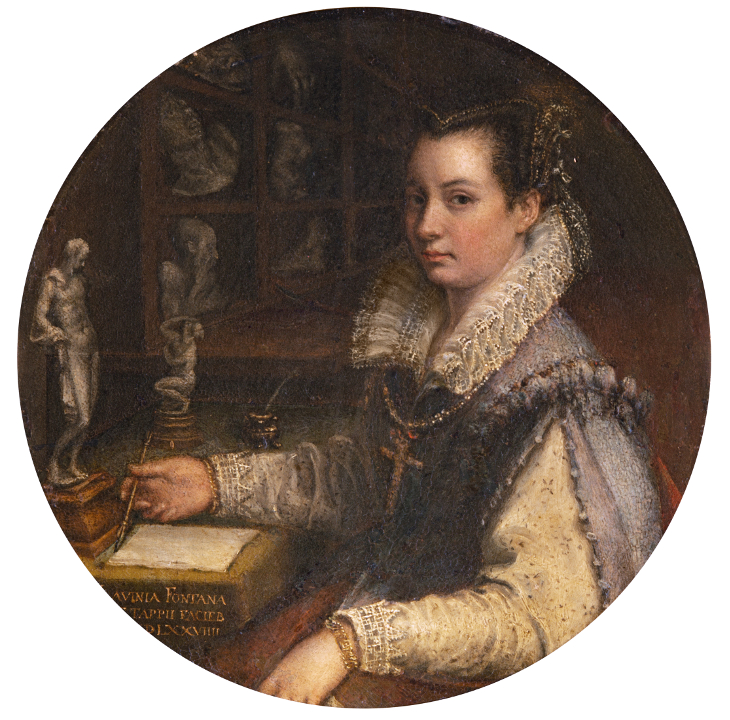Sofonisba Anguissola and Lavinia Fontana: A Tale of Two Women Painters

- Self-Portrait in the Studio, Lavinia Fontana, Oil on copper, 1579; Florence, Gallerie degli Uffizi, Galleria delle statue e delle pitture
Sofonisba Anguissola and Lavinia Fontana trained in Cremona and Bologna respectively; two geographically close artistic centres but ones characterised by their particular artistic, social and cultural traditions. They came from different types of families and had different lives although in both cases the role of their fathers had a fundamental influence on their careers. Both were able to overcome the stereotypes that society assigned to women in relation to artistic practice and the deep-rooted scepticism regarding their creative and artistic powers. As a result, they made use of painting to achieve a significant position in the society in which they lived.
One of six daughters, Sofonisba Anguissola was born into a family of the minor nobility in Cremona. Painting offered her the chance to achieve a social position appropriate to her family, the Anguissola-Ponzonis. Her abilities and personality combined with her father’s promotional skills led her to become a celebrated woman and one renowned for her virtue, furthering the possibilities of women in artistic roles and becoming a figure whose legend still survives today. Most noted for her portraiture, Anguissola was also summoned to serve as a lady-in-waiting to Isabel de Valois, a role that effectively concealed her true activities.
For Fontana, the daughter of a painter of some prestige, painting was a natural environment which, with the encouragement of her father, offered her a career. She was the first woman painter to be acknowledged as a professional and an artist who transcended the limits and pictorial genres imposed on women. Her extensive, wide-ranging oeuvre includes numerous portraits and religious works for churches and private oratories and she also painted religious compositions, a genre in which the nude was an important element.
- Self-Portrait at the Easel, Sofonisba Anguissola, Oil on canvas, c. 1556-57; Poland, The Castle - Museum in Łańcut
Sofonisba Anguissola (Cremona, ca.1535 - Palermo, 1625) and Lavinia Fontana (Bologna, 1552 - Rome, 1614) were two female pioneers of painting who achieved fame and recognition among their contemporaries. Both dismantled the social stereotypes assigned to women with regard to artistic practice, characterised by scepticism regarding their capabilities.
Anguissola came from a large family of noble origins. Her father, Amilcare Anguissola (ca.1494-1573) promoted and supported his daughter’s artistic training as part of a humanistic education considered appropriate for young people. Sofonisba primarily focused on portraiture and achieved a level of fame which, thanks to her aristocratic origins and her reputation as a virtuous woman, facilitated her arrival at the Spanish court where she became a lady-in-waiting to Queen Isabel de Valois. This position prevailed over her role as a painter but made her a reference point for other female artists.
Lavinia Fontana’s early years are comparable to those of most women artists. She was the daughter of Prospero Fontana (1512-1579), a prestigious Bolognese painter with whom she trained and worked. The city’s prosperous economic and social situation account for the prominent role of women in its cultural, religious, social and artistic life. Lavinia Fontana was the first woman to open her own studio where she embarked on a notably active career that would extend to Florence and Rome, before moving to the latter city towards the end of her life.
More Articles
- National Portrait Gallery Presents “Brilliant Exiles: American Women in Paris, 1900–1939"
- Rose Mula Reprise, Not My Parents' Church: It's Saturday Mass and I'm Wearing Slacks and Sneakers! No Hat! Not Even a Lace Square Pinned to My Head!
- Jo Freeman's Review of Yippie Girl: Exploits in Protest and Defeating the FBI
- Jo Freeman Reviews From Preaching to Meddling: A White Minister in the Civil Rights Movement
- Where We Stand: Partial Draft of Democratic Party Platform Already Voted Upon By Delegates; Covid-19 Pandemic Is a Prime Focus
- Stateline: Many Faithful Say It’s Time to Gather. Some Governors Disagree
- Correspondence Course: I Come From a Family of Communicators
- Sanditon by Jane Austen And Another Lady: "Women drive this ... They're so well written ..."
- Stories Behind the Numbers: When Laws Make Divorce Easier, US Census Bureau Research Show Women Benefit
- And Now for Something Different, Respected and Available to Project Gutenberg: Louisa May Alcott, Little Women and Other Writings








